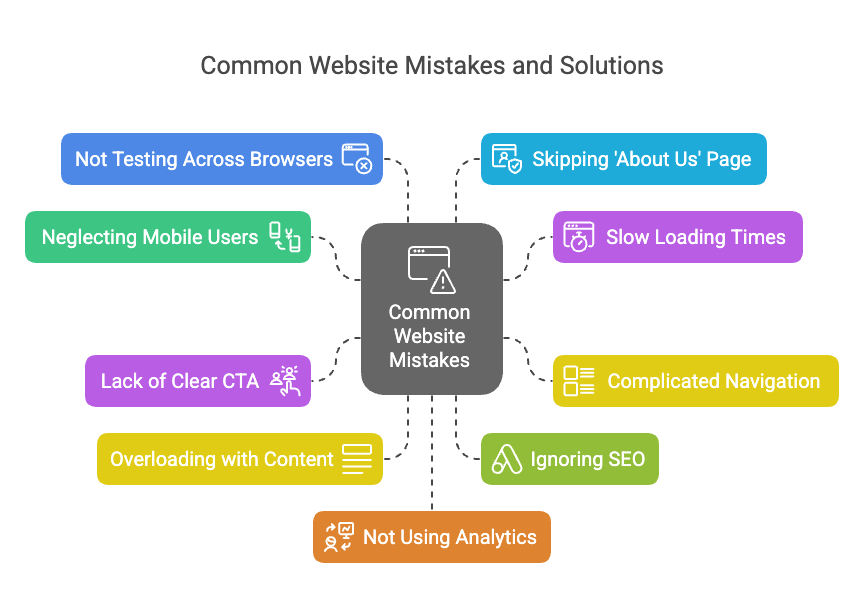The 10 Most Common Website Building Mistakes (And How to Avoid Them)
Building a website for your small business can feel like a big task, but it doesn’t have to be overwhelming. Whether you're doing it yourself or working with a designer, there are a few common mistakes many people make when building their websites. Luckily, with a bit of awareness, you can easily avoid these pitfalls. Here are the 10 most common website building mistakes and how to steer clear of them.

1. Neglecting Mobile Users
These days, most people browse websites on their phones. If your site isn’t mobile-friendly, you could be losing a lot of potential customers. Make sure your website looks good and works well on both desktops and smartphones.
How to Avoid It: When building your site, check how it looks on mobile devices. A good website builder, will automatically optimize your site for mobile, but it’s always a good idea to double-check!
2. Slow Loading Times
Nobody likes waiting for a website to load. If your website is too slow, people will leave before they even get to see what you offer. A slow website can hurt your business and your Google rankings.
How to Avoid It: Optimize your images (make sure they’re not too large), choose a reliable hosting provider, and avoid unnecessary animations or heavy files that can slow down your site.
3. Complicated Navigation
If visitors can’t find what they’re looking for quickly, they might leave and never return. Having a clear, easy-to-follow navigation menu is key to keeping visitors on your site.
How to Avoid It: Keep your menu simple and logical. Organize your pages in a way that makes sense and use clear, concise labels like “About Us,” “Products,” “Services,” and “Contact.”
4. Lack of a Clear Call to Action (CTA)
Every website should have a goal—whether it’s getting someone to contact you, buy a product, or sign up for a newsletter. If visitors don’t know what to do next, they might leave without taking any action.
How to Avoid It: Use clear and simple CTAs on your homepage and other key pages. For example, “Contact Us for a Free Quote” or “Shop Now.” Make sure your CTA buttons stand out and are easy to find.
5. Overloading with Content
While you want to provide enough information, packing too much text or too many images onto a page can overwhelm visitors. They may feel lost or confused.
How to Avoid It: Keep things simple and to the point. Break up text with headings, images, and bullet points. Make your pages easy to skim through.
6. Ignoring SEO (Search Engine Optimization)
If your website doesn’t show up in search engines like Google, how will potential customers find you? SEO is how search engines rank your website. Without it, your site could be buried on the 10th page of Google results.
How to Avoid It: Use relevant keywords on your site (words people might type when looking for your product or service). Tools like Google Analytics can help you track how your site is performing in search engines and what keywords are bringing people in.
7. Not Testing Across Browsers
Your website might look great in Chrome, but what about Safari or Firefox? Your website should look and work well across all major browsers, or else you could be alienating some users.
How to Avoid It: Before launching your site, test it in different browsers and on different devices. Many website builders, including JoyBird, offer features that allow you to preview your site on various platforms.
8. Skipping the ‘About Us’ Page
Your “About Us” page is one of the most visited pages on your site. It gives potential customers a chance to learn more about who you are and why they should trust your business.
How to Avoid It: Include a friendly, informative “About Us” page. Share your story, your values, and what makes your business stand out. Include a photo of your team or workspace to make it feel personal and welcoming.
9. Not Using Analytics
You may think your website is perfect, but how do you know for sure? Without tracking tools like Google Analytics, you won’t have any idea how visitors are interacting with your site.
How to Avoid It: Set up Google Analytics to track how visitors are finding and interacting with your website. This data can help you make informed decisions and improve your site over time.
10. Forgetting to Update Regularly
Websites need to be updated. A stale, outdated site with old information can make your business look unprofessional. Plus, search engines favor sites that are regularly updated.
How to Avoid It: Keep your website fresh by adding new content, updating old posts, and ensuring your business information is current. It’s also a good idea to regularly check for broken links or outdated images.
Building a website for your small business is an exciting step toward growth and success, but it’s important to do it right. By avoiding these common mistakes, you’ll have a website that not only looks great but also works well for your visitors and helps your business thrive. And remember, tools like JoyBird make the whole process much easier, even for those with little technical experience.
Happy building!